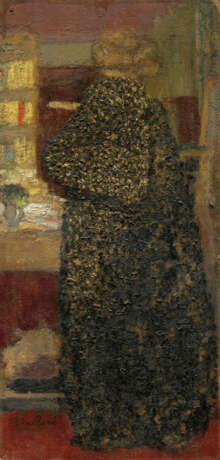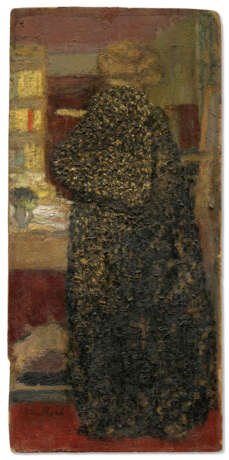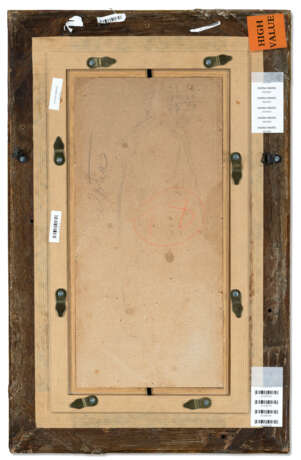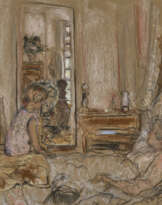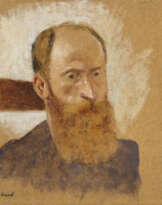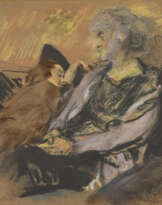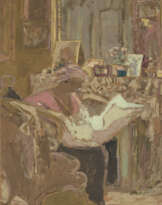ID 832369
Lot 161 | Édouard Vuillard (1868-1940)
Estimate value
€ 200 000 – 300 000
Misia en peignoir noir et jaune
signé 'E Vuillard' (en bas à gauche)
huile sur carton
32.2 x 15.3 cm.
Peint en 1896
signed 'E Vuillard' (lower left)
oil on board
12 5/8 x 6 1/8 in.
Painted in 1896
Provenance
Romain Coolus, Paris (vers 1897).
Alain Weil, Paris (don de celui-ci en 1947).
Collection particulière, France.
Galerie Bellier, Paris (en 1999).
Collection particulière, Paris.
Puis par descendance au propriétaire actuel.
Literature
A. Salomon et G. Cogeval, Vuillard, Le Regard innombrable, Catalogue critique des peintures et pastels, Paris, 2003, vol. I, p. 463, no. VI-7 (illustré en couleurs).
Exhibited
Paris, Musée des Arts Décoratifs, Exposition Vuillard, mai-juillet 1938, p. 7, no. 39 (titré 'Femme en peignoir noir et jaune').
Post Lot Text
Membre fondateur du groupe nabi, Édouard Vuillard a saisi, avec un talent et une sensibilité remarquables, une multitude de scènes de la vie quotidienne dans les intérieurs parisiens cossus qu'il fréquentait. Comme Bonnard, Vallotton et Toulouse-Lautrec, Vuillard était notamment un habitué des dîners chez les Natanson, couple mondain qui joua un rôle majeur dans l'histoire du symbolisme en France. Fondateur de La Revue blanche et grand amateur d'art, Thadée Natanson et son épouse, Misia, se plaisaient à faire salon dans leurs appartements parisiens et leur maison de campagne à Villeneuve-sur-Yonne.
« Misia porte ce même peignoir 'liberty' quand Vuillard la peint pendant la villégiature de Valvins. Ce beau tableau a appartenu pendant cinquante ans à Romain Coolus, un des rares du cercle de La Revue blanche à avoir peut-être obtenu des faveurs de la capricieuse épouse de Thadée Natanson » (cité in A. Salomon et G. Cogeval, op. cit., 2003, p. 463).
« J'ai toujours été bien timide auprès de vous, mais la sécurité, l'assurance d'une entente parfaite m'enlevait toute gêne et elle ne perdait rien à être toujours muette. » C'est avec une candeur inattendue que Vuillard, pourtant de nature réservée, adresse ces mots à son indéfectible muse, la très séduisante et charismatique Misia Natanson, l'objet de ses désirs brûlants mais non-partagés durant les dernières années du dix-neuvième siècle. La fascination de Vuillard pour Misia, laquelle se trouve alors à l'épicentre du cercle littéraire et artistique le plus avant-gardiste de Paris, trouve son expression la plus retentissante dans cette scène d'intérieur, marquée par une polyphonie de tons et de textures qui viennent à la fois sublimer l'intensité des émotions de l'artiste, et donner toute leur expression à ses fantasmes inassouvis. « Jamais Misia n’aura été aussi belle que dans ce tableau élégant et complexe », estime Guy Cogeval (A. Salomon et G. Cogeval, op. cit., 2003, p. 502).
Comme une conversion religieuse, totale, dévorante, la relation toujours plus étroite que Vuillard entretient avec le ménage Natanson va bouleverser l'existence de l'artiste. Au milieu des années 1890, il les voit presque tous les jours. À cette époque, Misia et son époux achètent les œuvres du peintre en quantité et les recommandent sans réserve à leur entourage ; ils lui offrent aussi un accès privilégié aux idées et aux formes artistiques les plus innovantes de leur temps et font preuve d'un art de vivre, d'une culture et d'un sens esthétique qui font l'admiration du jeune artiste. Dans ses portraits de Misia, Vuillard se détourne volontiers de la douceur contemplative de ses tableaux de famille pour exalter au contraire l'environnement fastueux des Natanson et la personnalité envoûtante de son modèle. « Le regard de Vuillard sur le réel, qui consiste à fondre les corps, les visages, les choses inanimées, les fleurs, les tentures, la lumière, dans une seule et même texture, il l’a consolidé et fixé au contact de Misia, dont l’avènement au sein de ses intérieurs tient chaque jour du miracle pour le peintre. […] En revanche il est aveuglant que sa peinture, même lorsque Misia est absente du cadre du tableau, est conditionnée par l’empreinte dans l’espace de son passage » (A. Salomon et G. Cogeval, op. cit., 2003, p. 454-455).
Dans cette œuvre, le drapé soyeux du vêtement, que Vuillard mue en une étoffe précieuse, devient le décor principal de la composition. Les couches denses de motifs et d'empâtements raccordent le premier et l'arrière-plan de cet ensemble richement orchestré, fusionnant les zones pénétrées par une perspective en trois dimensions et le plan pictural en deux dimensions. « L'espace ne se soustrait pas sous nos yeux ; on peut le caresser », écrit Russell (cat. exp., op. cit., 1971, p. 59). C'est ce traitement des matières et de leurs subtils effets décoratifs qui fait toute la singularité de l'art de Vuillard. Ici, le peintre nabi bannit volontairement les détails pour souligner l'atmosphère intimiste qui règne chez les Natanson, à la fois propice à l'amitié et à la créativité artistique. Cette scène confidentielle synthétise parfaitement le tempérament discret de Vuillard et la virtuosité avec laquelle il pouvait exprimer, en quelques coups de pinceau enlevés, l'élégance de ses figures. Comme les silhouettes d'un théâtre d'ombres, celles-ci rappellent l'engouement des symbolistes français pour les estampes japonaises, très en vogue durant la seconde moitié du XIXe siècle à Paris.
A founding member of the Nabi group, Édouard Vuillard captured, with great talent and sensitivity, scenes from everyday life in the cosseted surroundings of the Parisian apartments he frequented. With Bonnard, Vallotton and Toulouse-Lautrec, Édouard Vuillard was one of the regular dinner guests of the Natanson's, a couple who played a major role in the history of French symbolism. Founder of the Revue Blanche and a great art lover, Thadée Natanson and his wife Misia played host both in Paris and at their villa in Villeneuve-sur-Yonne.
"Misia was wearing the same 'liberty print' robe when Vuillard painted her during the stay in Valvins. For fifty years, this beautiful painting belonged to Romain Coolus, one of the few members of the circle around La Revue blanche to have perhaps won the favour of Thadée Natanson's whimsical wife" (in A. Salomon and G. Cogeval, op. cit., 2003, p. 463).
“I have always been shy in your presence, but the security, the assurance of a perfect understanding relieved me of all embarrassment; nothing was lost by this understanding being a wordless one.”
So wrote the typically reticent Vuillard, with unexpected candor, to the prodigiously charismatic and alluring Misia Natanson, his perennial muse and the object of his unrequited infatuation during the last years of the nineteenth century. Vuillard’s enchantment with Misia, who constituted the very epicenter of Paris’s most advanced artistic and literary circle at this time, finds its most poignant and intimate expression in the present interior, a polyphony of color and texture that represents both a lyric sublimation of the artist’s intense emotions and a fantasy of his desires fulfilled. “Nowhere is Misia more beautiful than in this elaborate, elegant composition,” Guy Cogeval has declared (A. Salomon and G. Cogeval, op. cit., 2003, p. 502).
For Vuillard, his deepening relationship with the Natansons was like a religious conversion, life-changing and all-consuming. By the middle of the decade, he saw them almost daily. They purchased his work in quantity and recommended him unreservedly to friends; they afforded him inside access to the very latest in arts and ideas, and they demonstrated a way of life—a taste and a culture—that fascinated the young artist. In his paintings of Misia, Vuillard eschewed the quiet contemplativeness of his family scenes and gloried instead in the luxury of the Natansons’ environment and the arresting personality of his model. “Vuillard’s vision of reality,” Cogeval has written, “which melded bodies, faces, inanimate objects, flowers, draperies and light into a single texture, was developed and supported by his contact with Misia, whose appearance in the interiors he painted represented a daily miracle for him. His painting, even when Misia was not in the picture, was conditioned by the imprint in space of her passing” (A. Salomon and G. Cogeval, op. cit., 2003, p. 454-455).
In the present work, having been transformed into precious drapery, the smooth fabric of her robe becomes the main decoration in the scene. The densely layered patterns and textures knit together foreground and background in this richly orchestrated scene, causing three-dimensional perspectival space to merge with the two-dimensional picture plane. “Space does not retreat before us; we can caress it,” Russell has written (exh. cat., op. cit., 1971, p. 59). Vuillard's art stands out due to his treatment of materials and the rich decorative effects they conceal. The Nabi painter deliberately banishes details to further express the intimate atmosphere which reigned at the Natansons' and was conducive to both friendship and pictorial creativity. This private scene sums up Vuillard's discrete nature and his talent for expressing, with almost sketched strokes, the elegance of figures. Like shadow puppets outlined on the back of the stage, they recall the craze among French symbolists for Japanese engravings, which were very fashionable in Paris during the second half of the XIXth century.
| Artist: | Édouard Vuillard (1868 - 1940) |
|---|---|
| Applied technique: | Oil, Painted |
| Auction house category: | Paintings |
| Artist: | Édouard Vuillard (1868 - 1940) |
|---|---|
| Applied technique: | Oil, Painted |
| Auction house category: | Paintings |
| Address of auction |
CHRISTIE'S 9 Avenue Matignon 75008 Paris France | ||||||||||||||
|---|---|---|---|---|---|---|---|---|---|---|---|---|---|---|---|
| Preview |
| ||||||||||||||
| Phone | +33 (0)1 40 76 85 85 | ||||||||||||||
| Fax | +33 (0)1 40 76 85 86 | ||||||||||||||
| Conditions of purchase | Conditions of purchase | ||||||||||||||
| Shipping |
Postal service Courier service pickup by yourself | ||||||||||||||
| Payment methods |
Wire Transfer | ||||||||||||||
| Business hours | Business hours
|
